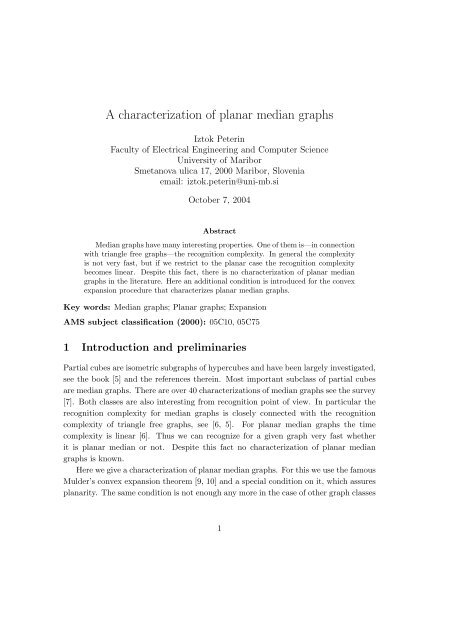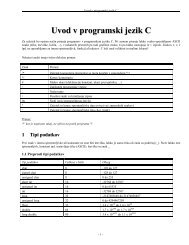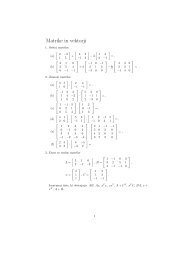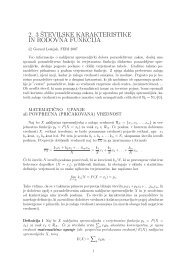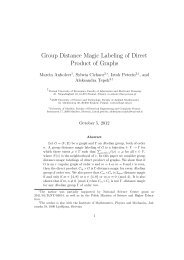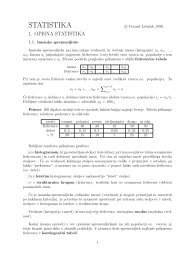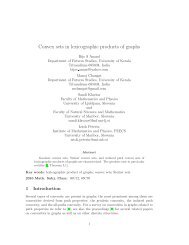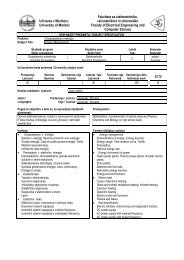A characterization of planar median graphs
A characterization of planar median graphs
A characterization of planar median graphs
Create successful ePaper yourself
Turn your PDF publications into a flip-book with our unique Google optimized e-Paper software.
A <strong>characterization</strong> <strong>of</strong> <strong>planar</strong> <strong>median</strong> <strong>graphs</strong><br />
Iztok Peterin<br />
Faculty <strong>of</strong> Electrical Engineering and Computer Science<br />
University <strong>of</strong> Maribor<br />
Smetanova ulica 17, 2000 Maribor, Slovenia<br />
email: iztok.peterin@uni-mb.si<br />
October 7, 2004<br />
Abstract<br />
Median <strong>graphs</strong> have many interesting properties. One <strong>of</strong> them is—in connection<br />
with triangle free <strong>graphs</strong>—the recognition complexity. In general the complexity<br />
is not very fast, but if we restrict to the <strong>planar</strong> case the recognition complexity<br />
becomes linear. Despite this fact, there is no <strong>characterization</strong> <strong>of</strong> <strong>planar</strong> <strong>median</strong><br />
<strong>graphs</strong> in the literature. Here an additional condition is introduced for the convex<br />
expansion procedure that characterizes <strong>planar</strong> <strong>median</strong> <strong>graphs</strong>.<br />
Key words: Median <strong>graphs</strong>; Planar <strong>graphs</strong>; Expansion<br />
AMS subject classification (2000): 05C10, 05C75<br />
1 Introduction and preliminaries<br />
Partial cubes are isometric sub<strong>graphs</strong> <strong>of</strong> hypercubes and have been largely investigated,<br />
see the book [5] and the references therein. Most important subclass <strong>of</strong> partial cubes<br />
are <strong>median</strong> <strong>graphs</strong>. There are over 40 <strong>characterization</strong>s <strong>of</strong> <strong>median</strong> <strong>graphs</strong> see the survey<br />
[7]. Both classes are also interesting from recognition point <strong>of</strong> view. In particular the<br />
recognition complexity for <strong>median</strong> <strong>graphs</strong> is closely connected with the recognition<br />
complexity <strong>of</strong> triangle free <strong>graphs</strong>, see [6, 5]. For <strong>planar</strong> <strong>median</strong> <strong>graphs</strong> the time<br />
complexity is linear [6]. Thus we can recognize for a given graph very fast whether<br />
it is <strong>planar</strong> <strong>median</strong> or not. Despite this fact no <strong>characterization</strong> <strong>of</strong> <strong>planar</strong> <strong>median</strong><br />
<strong>graphs</strong> is known.<br />
Here we give a <strong>characterization</strong> <strong>of</strong> <strong>planar</strong> <strong>median</strong> <strong>graphs</strong>. For this we use the famous<br />
Mulder’s convex expansion theorem [9, 10] and a special condition on it, which assures<br />
<strong>planar</strong>ity. The same condition is not enough any more in the case <strong>of</strong> other graph classes<br />
1
that can be obtain by some other expansion procedures. For more about this classes<br />
<strong>of</strong> <strong>graphs</strong> we recommend [2] and the references therein.<br />
The distance d G (u, v) between two vertices u and v in a graph G is defined as the<br />
number <strong>of</strong> edges on a shortest u, v-path. A subgraph H <strong>of</strong> G is called isometric, if<br />
d H (u, v) = d G (u, v) for all u, v ∈ V (H) and H is convex if for every u, v ∈ V (H) all<br />
shortest u, v-paths belong to H. Convex sub<strong>graphs</strong> are isometric.<br />
The Cartesian product G✷H <strong>of</strong> two <strong>graphs</strong> G and H is the graph with vertex set<br />
V (G) × V (H) where the vertex (a, x) is adjacent to (b, y) whenever ab ∈ E(G) and<br />
x = y, or a = b and xy ∈ E(H). Hypercubes or n-cubes Q n are Cartesian products <strong>of</strong><br />
n copies <strong>of</strong> K 2 . Isometric sub<strong>graphs</strong> <strong>of</strong> hypercubes are called partial cubes.<br />
A graph G is a <strong>median</strong> graph if there exists a unique vertex x to every triple <strong>of</strong><br />
vertices u, v, and w <strong>of</strong> G such that x lies on a shortest u, v-path, on a shortest u, w-path,<br />
and on a shortest v, w-path. Trees and n-cubes are <strong>median</strong> <strong>graphs</strong>.<br />
Let G 1 and G 2 be a cover <strong>of</strong> a graph G with nonempty intersection G 1 ∩ G 2 = G ′<br />
and with no edge from G 1 \G ′ to G 2 \G ′ . Graph H is an expansion <strong>of</strong> G with respect<br />
to G 1 and G 2 as follows. Take disjoint copies <strong>of</strong> G 1 and G 2 and connect every vertex<br />
from G ′ in G 1 with the same vertex <strong>of</strong> G ′ in G 2 with an edge. Such pairs <strong>of</strong> vertices<br />
will be called expansions neighbors. Expansion is peripheral if G 1 = G (or G 2 = G).<br />
In that case G ′ = G 2 and we say that H is a peripheral expansion <strong>of</strong> G with respect to<br />
G ′ . We say that expansion is convex (isometric, connected, arbitrary) if G ′ is convex<br />
(isometric, connected, arbitrary). It is not hard to see that copies <strong>of</strong> G ′ in G 1 and in<br />
G 2 and new edges between those two copies form the Cartesian product G ′ ✷K 2 .<br />
In [9, 10] Mulder has shown that G is <strong>median</strong> if and only if it can be obtained from<br />
K 1 by a sequence <strong>of</strong> convex expansions, in [11] he has shown that we can restrict to<br />
pheripheral expansions, and in [3] Chepoi has shown that G is a partial cube if and<br />
only if it can be obtained from K 1 by a sequence <strong>of</strong> arbitrary expansions.<br />
We say that a bipartite graph G satisfies the quadrangle property if for any vertices<br />
u, w, x, y <strong>of</strong> G with a d(u, x) = d(u, y) = k = d(u, w) − 1 and w is a common neighbor<br />
<strong>of</strong> x and y, there exists a common neighbor v <strong>of</strong> x and y with d(u, v) = k − 1. Median<br />
<strong>graphs</strong> are precisely connected bipartite <strong>graphs</strong> that fulfill the quadrangle property and<br />
contain no induced K 2,3 , cf. [7].<br />
Graph G is <strong>planar</strong> if it can be drawn in the plane such that any two edges cross<br />
only in an endvertex (if they are incident with the same endvertex). Such drawings<br />
are called plane drawings <strong>of</strong> G. Any plane drawing <strong>of</strong> G divides the plane into regions<br />
which are called faces. One <strong>of</strong> those faces is unbounded and is called the exterior or the<br />
outer face, the others are interior or inner faces. Vertices that lie on an outer face are<br />
called outer vertices and other are inner vertices. Note that the boundary <strong>of</strong> every face<br />
<strong>of</strong> some plane drawing can be boundary <strong>of</strong> an outer face <strong>of</strong> some other plane drawing<br />
2
<strong>of</strong> the same graph.<br />
A graph G is outer<strong>planar</strong> if it is <strong>planar</strong> and embeddable into the plane so that<br />
all vertices lie on the outer face <strong>of</strong> the embedding. Such an embedding is called an<br />
outer<strong>planar</strong> embedding <strong>of</strong> G. In [1] Behzad and Mahmoodian have shown that G is<br />
outer<strong>planar</strong> if and only if G✷K 2 is <strong>planar</strong>. For more information about <strong>planar</strong> <strong>graphs</strong><br />
(or more general <strong>graphs</strong> on surfaces) we recommend [8].<br />
2 Face expansions<br />
Vertex u <strong>of</strong> a connected graph G is a cut vertex if G − u is disconnected, while edge<br />
e is a bridge if G − e is disconnected. (We remove only edge e without endvertices.)<br />
Suppose that the boundary <strong>of</strong> a face F is not a simple closed curve. Then there exists<br />
a cut vertex u on F . Then G − u is a disconnected graph with connected components<br />
C 1 , . . . , C p . Add the vertex u back to all components C i , i = 1, 2, . . . , p, in the natural<br />
way whenever u was adjacent to at least two vertices <strong>of</strong> C i and denote this graph with<br />
G + u . Note that if uv is a bridge then uv is not an edge in G + u . With G + we denote the<br />
graph that remains from a G after this procedure is executed for all cut vertices <strong>of</strong> G.<br />
We say that a face F is (non)induced, if the cycle that contain edges <strong>of</strong> F is<br />
(non)induced in G. Vertices <strong>of</strong> any induced cycle are clearly in the same connected<br />
component <strong>of</strong> G + .<br />
With this terminology we can write a simple lemma for drawings <strong>of</strong> a graph. The<br />
rather technical pro<strong>of</strong> is omitted.<br />
Lemma 1 Let D be a <strong>planar</strong> drawing <strong>of</strong> a graph G and F some noninduced face with<br />
vertices u 0 , . . . , u k . Suppose that there exists edge u 0 u i , i ∈ {2, . . . , k − 1}. Then there<br />
exists a drawing D ′ with a face F ′ on vertices u 0 , u i , u i+1 , . . . , u k .<br />
Let H be an expansion <strong>of</strong> a <strong>planar</strong> graph G with respect to G 1 and G 2 . Then H<br />
is a face expansion <strong>of</strong> G if all vertices <strong>of</strong> G ′ = G 1 ∩ G 2 are on one face <strong>of</strong> some plane<br />
drawing <strong>of</strong> G. We need another lemma before our main result.<br />
Lemma 2 Let H be a peripheral expansion <strong>of</strong> a <strong>planar</strong> graph G with respect to G ′ .<br />
Suppose that among any two incident edges e = uv and f = vw from G ′ at least one is<br />
a bridge in G or v is a cut vertex and e and f are in different connected components<br />
<strong>of</strong> G + . Then H is a peripheral face expansion <strong>of</strong> G with respect to G ′ .<br />
Pro<strong>of</strong>. Clearly G ′ does not contain any cycle and is a tree. In each component C i <strong>of</strong><br />
G + is at most one edge <strong>of</strong> G ′ . If there is such an edge e i in C i , choose any face F i in<br />
C i that contains e i and draw C i in such a way that F i is an outer face <strong>of</strong> C i . Draw all<br />
3
others components in any <strong>planar</strong> way. All edges <strong>of</strong> G ′ that are still missing in G + are<br />
bridges. Return those bridges to G + and join those cut vertices <strong>of</strong> G that are incident<br />
with an edge from G ′ that is not a bridge. Clearly G ′ is on outer face <strong>of</strong> this drawing.<br />
We add all other bridges <strong>of</strong> G to this drawing and join all other cut vertices <strong>of</strong> G that<br />
have been disjoint. The outer face <strong>of</strong> the obtained drawing <strong>of</strong> G still includes G ′ and<br />
thus H is a peripheral face expansion.<br />
✷<br />
Theorem 3 A graph G is a <strong>planar</strong> <strong>median</strong> graph if and only if G can be obtained from<br />
K 1 by a sequence <strong>of</strong> convex peripheral face expansions.<br />
Pro<strong>of</strong>. Suppose that G can be obtained from K 1 by a sequence <strong>of</strong> convex peripheral<br />
face expansions. Then G is <strong>median</strong> by Mulder’s convex expansion theorem. We will<br />
show that face expansions preserve <strong>planar</strong>ity by induction on the number <strong>of</strong> expansions.<br />
Let H 0 = K 1 and denote with H k the graph obtained after k peripheral expansions<br />
with corresponding subgraph H<br />
k ′ for the next peripheral expansion. Suppose that H k<br />
is <strong>planar</strong> and that it is drawn in such a way that H k+1 can be obtained from H k with a<br />
face expansion. Denote this face with F . Then H<br />
k ′ is outer<strong>planar</strong> and H′ k ✷K 2 is <strong>planar</strong><br />
by the result <strong>of</strong> Behzad and Mahmoodian. Draw H k and H<br />
k ′ so that F is an outerface<br />
for both <strong>of</strong> them and that drawings do not intersect. Now just connect by an edge<br />
every vertex <strong>of</strong> H<br />
k ′ in the drawing <strong>of</strong> H k with the same vertex in the drawing <strong>of</strong> H<br />
k ′ .<br />
Clearly this can be done so that a new drawing <strong>of</strong> H k+1 is <strong>planar</strong>. Hence G is <strong>planar</strong>.<br />
Suppose now that G is <strong>planar</strong> and <strong>median</strong>. Then G can be obtain by a sequence<br />
<strong>of</strong> convex peripheral expansions from K 1 by Mulder’s theorem. Assume that one <strong>of</strong><br />
this expansions, say H k to H k+1 with respect to H<br />
k ′ , is not a face expansion for every<br />
drawing <strong>of</strong> a graph H k . Choose index k to be the smallest <strong>of</strong> all such expansions and<br />
fix one drawing D.<br />
By Lemma 2 there are at least two incident edges in H<br />
k ′ that are in the same<br />
connected components <strong>of</strong> H + k<br />
. We distinguish three cases:<br />
Case 1 H ′ k has two incident edges that are in the same connected component <strong>of</strong> H+ k<br />
and are not on a four cycle.<br />
We will show that no two such edges <strong>of</strong> H ′ k<br />
lie on the same face. Assume contrary<br />
that edges e = uv and f = vw that are in the same connected component C j <strong>of</strong> H + k<br />
are on the same face F <strong>of</strong> D. Then there exists some u, w-path other than uvw. Among<br />
all such paths choose the shortest one and denoted with P . Clearly P has even length<br />
and cycle wvuP is isometric. Let x be a middle vertex <strong>of</strong> P . For |P | = 2 vertices uvwx<br />
form a four cycle and if |P | > 2 there exist a vertex z so that uvwz form a four cycle<br />
by the quadrangle property for x, u, w, v. In each case H<br />
k ′ contains a cycle, since the<br />
expansion is convex, contrary to the assumption.<br />
4
Thus there are two edges e = u 1 u 2 and f = u 1 u 3 in H<br />
k ′ which are not on the same<br />
face in D. Denote with x 1 , x 2 , . . . , x p and y 1 , y 2 , . . . , y q neighbors <strong>of</strong> u 1 in C j in H + k ,<br />
where x i are on the one side and y j on the other side <strong>of</strong> the path u 2 u 1 u 3 on drawing D.<br />
Since u 2 and u 3 are not on the same face <strong>of</strong> D, we have p ≥ 1 and q ≥ 1. Let v 1 = x 1 ,<br />
v 2 = y 1 , and v 3 be the expansion neighbor <strong>of</strong> u 1 . We will show that {u 1 , u 2 , u 3 } and<br />
{v 1 , v 2 , v 3 } form a partition <strong>of</strong> subdivision <strong>of</strong> K 3,3 .<br />
Vertex u 1 is a neighbor <strong>of</strong> v 1 , v 2 , and v 3 . Let u ′ 2 and u′ 3 be expansions neighbors <strong>of</strong><br />
u 2 and u 3 in H k+1 , respectively. Then v 3 u ′ 2 u 2 and v 3 u ′ 3 u 3 are edge disjoint paths from<br />
v 3 to u 2 and u 3 , respectively. Even more, none <strong>of</strong> edges on those paths are in H k .<br />
For u 2 = x 0 and u 3 = x p+1 path x i u 1 x i+1 is on the same face F i <strong>of</strong> C j , for i ∈<br />
{0, 1, . . . , p}. The path F 0 \{u 2 u 1 v 1 } is a v 1 , u 2 -path, the path F 1 \{u 2 u 1 v 1 } is a v 1 , u 3 -<br />
path if p = 1, and the symmetric sum<br />
F 1 \{u 1 v 1 } ⊕ F p \{u 1 u 3 } ⊕ p−1<br />
i=2 F i<br />
is a v 1 , u 3 -path if p > 1. Analogously for u 3 = y 0 and u 2 = y q+1 the path y i u 1 y i+1 is<br />
on the same face E i , for i ∈ {0, 1, . . . , q}. The path E 0 \{u 3 u 1 v 2 } is a v 2 , u 3 -path, the<br />
path E 1 \{u 3 u 1 v 2 } is a v 2 , u 2 -path if q = 1, and the symmetric sum<br />
E 1 \{u 1 v 2 } ⊕ E q \{u 1 u 3 } ⊕ q−1<br />
i=2 E i<br />
is a v 2 , u 2 -path.<br />
All these paths are edge disjoint and we have a subdivision <strong>of</strong> K 3,3 in H + k+1 and<br />
thus in G, which is impossible.<br />
Case 2 H ′ k has a four cycle C 4 = uvxy.<br />
Suppose that this cycle is not a boundary <strong>of</strong> any face on any drawing <strong>of</strong> G. We<br />
claim that at most two incident edges <strong>of</strong> H<br />
k ′ are on the same face. Indeed, if there<br />
are three edges <strong>of</strong> H<br />
k ′ on the face F , F is not induced. By Lemma 1 there exists a<br />
drawing D ′ where H<br />
k ′ is a boundary <strong>of</strong> a face. We do the same if two nonincident edges<br />
lie on the same face. However this is not enough. We have to show also that any two<br />
incident edges <strong>of</strong> H<br />
k ′ are not on the same face. Suppose they are. Without loss <strong>of</strong><br />
generality we may assume that there exist an u, x-path P and a v, y-path Q. P and Q<br />
must have even length. If P = uwx has length two, vertices u, v, x, y, w form a K 2,3<br />
which is impossible. So let |P | > 2. Then there exists a common neighbor z <strong>of</strong> u and x<br />
by the quadrangle property for vertices u, x, v, and for the middle vertex <strong>of</strong> P . Again<br />
u, v, x, y, z form a K 2,3 , a contradiction for a <strong>median</strong> graph.<br />
As in Case 1 we thus have two edges e = u 1 u 2 and f = u 1 u 3 in H<br />
k ′ which are not<br />
on the same face in D ′ . We proceed as in Case 1.<br />
5
Case 3 In H ′ k are three edges that are all incident with vertex u 1 and are in the same<br />
connected component <strong>of</strong> H + k .<br />
Let u 1 be a vertex in H<br />
k ′ with at least three neighbors u 2, u 3 , u 4 ∈ H<br />
k ′ in the same<br />
connected component C j <strong>of</strong> H + k<br />
. Clearly these three edges are all not on the same face<br />
<strong>of</strong> D.<br />
We will use the following notation. Let x 1 , x 2 , . . . , x p , y 1 , y 2 , . . . , y q and z 1 , z 2 , . . . , z r<br />
be neighbors <strong>of</strong> u 1 in C j such that x i , y i and z i lie on D between u 2 and u 3 , between u 3<br />
and u 4 , and between u 4 and u 2 , respectively. Denote with u 5 the expansion neighbor <strong>of</strong><br />
u 1 . We claim that {u 1 , u 2 , u 3 , u 4 , u 5 } form a subdivision <strong>of</strong> K 5 —a contradiction with<br />
<strong>planar</strong>ity <strong>of</strong> G.<br />
Vertex u 1 is a neighbor <strong>of</strong> u 2 , u 3 , u 4 , and u 5 . Let u ′ 2 , u′ 3 , and u′ 4 be expansions<br />
neighbors <strong>of</strong> u 2 , u 3 , and u 4 in H k+1 respectively. Then u 5 u ′ 2 u 2, u 5 u ′ 3 u 3, and u 5 u ′ 4 u 4 are<br />
edge disjoint paths from u 5 to u 2 , u 3 , and u 4 respectively. Even more, none <strong>of</strong> edges<br />
on those paths are in H k .<br />
For u 2 = x 0 and u 3 = x p+1 the path x i u 1 x i+1 is on the same face Fi<br />
23 , for i ∈<br />
{0, 1, . . . , p}. Then F 0 \{u 2 u 1 u 3 } is a u 2 , u 3 -path if p = 0 and the symmetric sum<br />
F 23<br />
0 \{u 2 u 1 } ⊕ Fp<br />
23 \{u 3 u 1 } ⊕ p−1<br />
i=1 F i<br />
23<br />
forms a u 2 , u 3 -path if p > 0. Analogously for u 3 = y 0 and u 4 = y q+1 the path y i u 1 y i+1<br />
is on the same face Fi 34 , for i ∈ {0, 1, . . . , q}. Then F0 34\{u<br />
3u 1 u 4 } is a u 3 , u 4 -path if<br />
q = 0 and the symmetric sum<br />
F 34<br />
0 \{u 3 u 1 } ⊕ Fq<br />
34 \{u 4 u 1 } ⊕ q−1<br />
i=1 F i<br />
34<br />
forms a u 3 , u 4 -path if q > 0. And finally for u 4 = z 0 and u 2 = z r+1 the path z i u 1 z i+1 is<br />
on the same face Fi 42 , for i ∈ {0, 1, . . . , r}. Then F0 42\{u<br />
4u 1 u 2 } is a u 4 , u 2 -path if r = 0<br />
and the symmetric sum<br />
F 42<br />
0 \{u 4 u 1 } ⊕ Fr<br />
42 \{u 2 u 1 } ⊕ r−1<br />
i=1 F i<br />
42<br />
forms a u 4 , u 2 -path if r > 0.<br />
complete.<br />
Clearly all these paths are disjoint and the pro<strong>of</strong> is<br />
✷<br />
As already mentioned the same argument does not hold for <strong>graphs</strong> obtainable from<br />
K 1 by a sequence <strong>of</strong> isometric (connected, any) expansions. Counterexample due to<br />
Klavžar for isometric expansion is a graph H that is an isometric expansion <strong>of</strong> cube the<br />
Q 3 with respect to two <strong>graphs</strong> Q − 3 , so that Q′ 3 is isometric C 6. (Q − 3 is a cube Q 3 minus<br />
a vertex.) Clearly H is <strong>planar</strong> but the mentioned expansion is not a face expansion<br />
and also can not be obtained from face expansions.<br />
6
Acknowledgment The author wish to thanks to Sandi Klavžar for several discussions<br />
and useful comments to the text.<br />
References<br />
[1] M. Behzad, E. S. Mahmoodian, On topological invariants <strong>of</strong> the product <strong>of</strong> <strong>graphs</strong>,<br />
Canad. Math. Bull. 12 (1969) 157–166.<br />
[2] B. Brešar, W. Imrich, S. Klavžar, H. M. Mulder, R.<br />
cubes, J. Graph Theory 40 (2002) 91–103.<br />
Škrekovski, Tiled partial<br />
[3] V. D. Chepoi, Isometric sub<strong>graphs</strong> <strong>of</strong> Hamming <strong>graphs</strong> and d-convexity, (Russian)<br />
Kibernetika (Kiev) (1988) 6–9; translation in Cybernetics 24 (1988) 6–11.<br />
[4] D. Djoković, Distance preserving sub<strong>graphs</strong> <strong>of</strong> hypercubes, J. Combin. Theory Ser.<br />
B 14 (1973) 263–267.<br />
[5] W. Imrich and S. Klavžar, Product Graphs: Structure and Recognition (John<br />
Wiley & Sons, New York, 2000).<br />
[6] W. Imrich, S. Klavžar, H.M. Mulder, Median <strong>graphs</strong> and triangle-free <strong>graphs</strong>,<br />
SIAM J. Discrete Math. 12 (1999) 111–118.<br />
[7] S. Klavžar, H.M. Mulder, Median <strong>graphs</strong>: <strong>characterization</strong>, location theory and<br />
related structures, J. Combin. Math. Combin. Comp. 30 (1999) 103–127.<br />
[8] B. Mohar and C. Thomassen, Graphs on Surfaces (Johns Hopkins University Press,<br />
Baltimore, MD, 2001).<br />
[9] H. M. Mulder, The structure <strong>of</strong> <strong>median</strong> <strong>graphs</strong>, Discrete Math. 24 (1978) 197–204.<br />
[10] H. M. Mulder, The Interval Function <strong>of</strong> a Graph (Mathematical Centre Tracts<br />
132, Mathematisch Centrum, Amsterdam, 1980).<br />
[11] H. M. Mulder, The expansion procedure for <strong>graphs</strong>, Contemporary methods in<br />
graph theory 459–477 Bibliographisches Inst. Mannheim, 1990.<br />
[12] P. M. Winkler, Isometric embedding in products <strong>of</strong> complete <strong>graphs</strong>, Discrete<br />
Appl. Math. 7 (1984) 221–225.<br />
7


